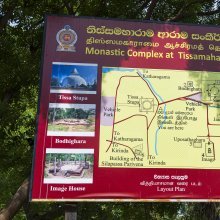Samkirna, Saṅkīrṇa, Saṃkīrṇa, Sankirna: 21 definitions
Introduction:
Samkirna means something in Buddhism, Pali, Hinduism, Sanskrit, Jainism, Prakrit, Marathi, Hindi. If you want to know the exact meaning, history, etymology or English translation of this term then check out the descriptions on this page. Add your comment or reference to a book if you want to contribute to this summary article.
Alternative spellings of this word include Sankirn.
Images (photo gallery)
In Hinduism
Vastushastra (architecture)
Source: Wisdom Library: Vāstu-śāstraSaṅkīrṇa (सङ्कीर्ण) refers to classification of a temple/buidling (prāsāda), according to Samarāṅgaṇasūtradhāra chapter 60. The temple is mentioned in a list of thirty-six Prāsādas having activities of the townsmen entailing Sādhārās. The Samarāṅgaṇasūtradhāra is an 11th-century encyclopedia dealing with various topics from the Vāstuśāstra.
Source: Brill: Śaivism and the Tantric Traditions (architecture)Saṅkīrṇa (सङ्कीर्ण) refers to a “polluted” (as opposed to Asaṅkīrṇa—‘an unpolluted place’), according to the Devyāmata (chapter 105).—Accordingly, [while describing the construction of residence for initiates]—“[...] The residence for the initiates should be built not too far from water. Initiates should live in a fine, unpolluted (asaṅkīrṇa) place. The residence should have one, two, or three rooms. Or a four-roomed residence should be built, according to funding. A pleasing hiraṇyanābha or sukṣetra may be built”.

Vastushastra (वास्तुशास्त्र, vāstuśāstra) refers to the ancient Indian science (shastra) of architecture (vastu), dealing with topics such architecture, sculpture, town-building, fort building and various other constructions. Vastu also deals with the philosophy of the architectural relation with the cosmic universe.
Purana and Itihasa (epic history)
Source: Cologne Digital Sanskrit Dictionaries: The Purana IndexSaṅkīrṇa (सङ्कीर्ण).—A son of Abhramu elephant, the vehicle of Yama; (also Añjana) a Diggaja;1 a nāga with the sun in the spring.2

The Purana (पुराण, purāṇas) refers to Sanskrit literature preserving ancient India’s vast cultural history, including historical legends, religious ceremonies, various arts and sciences. The eighteen mahapuranas total over 400,000 shlokas (metrical couplets) and date to at least several centuries BCE.
Natyashastra (theatrics and dramaturgy)
Source: Wisdom Library: Nāṭya-śāstraSaṅkīrṇa (सङ्कीर्ण) or saṅkīrṇarāga is defined as the merged product of śuddha-rāgas (Śiva-form) and sālaga-rāgas (Śakti-form), according to Umāpati in his 9th century Aumāpatam (exposition on music and dance). Merged with śuddha-rāgas, they become known as saṅkīrṇa.
Source: HAL: The Karpūramañjarī and its successorsSaṃkīrṇa (संकीर्ण) refers to a “hybrid genre of classical Indian theater” (i.e., saṃkīrṇa-rūpaka).—For example: Saṭṭaka, which is related to another similar genre, nāṭikā. Both are love comedies in four acts, characterized by the use of numerous female characters, as well as the abundant use of dancing, singing and music. The ending is always happy, as we find in the Ratnāvalī and the Priyadarśikā of Harṣa (7th century, Kannauj). Because of this musical aspect and the cheerfulness represented by these hybrid genres, nāṭikā has been noted among the ten great dramatic genres (rūpaka) in treatises on Indian theatrical art, and has enjoyed great popularity within royal courts.

Natyashastra (नाट्यशास्त्र, nāṭyaśāstra) refers to both the ancient Indian tradition (shastra) of performing arts, (natya—theatrics, drama, dance, music), as well as the name of a Sanskrit work dealing with these subjects. It also teaches the rules for composing Dramatic plays (nataka), construction and performance of Theater, and Poetic works (kavya).
Shaivism (Shaiva philosophy)
Source: Shodhganga: Temple management in the ĀgamasSaṅkīrṇa (सङ्कीर्ण) or Saṅkīrṇapūjā refers to a classification of pūjā (ritualistic worship) according to the Ajitāgama (20.19).—The Āgamas have several different classifications of nityapūjā (daily worship), based on the number of offerings, frequency, time duration and so on. The nomenclature also varies between Āgamas. The essence however is similar. Ajitāgama has a different nomenclature and classifies pūjā into śuddha, miśra and saṅkīrṇa. That which ends with havis or naivedya is termed śuddha. That which ends with nityotsava is termed miśra. That which ends with śuddhanṛtta is termed saṅkīrṇa.

Shaiva (शैव, śaiva) or Shaivism (śaivism) represents a tradition of Hinduism worshiping Shiva as the supreme being. Closely related to Shaktism, Shaiva literature includes a range of scriptures, including Tantras, while the root of this tradition may be traced back to the ancient Vedas.
Ayurveda (science of life)
Veterinary Medicine (The study and treatment of Animals)
Source: archive.org: The Elephant Lore of the HindusSaṅkīrṇa (सङ्कीर्ण) or Saṅkīrṇajāti refers to the “mixed caste (of elephants)”, according to the 15th century Mātaṅgalīlā composed by Nīlakaṇṭha in 263 Sanskrit verses, dealing with elephantology in ancient India, focusing on the science of management and treatment of elephants.—[Cf. chapter 1, “on the origin of elephants”]: “[...] The elephants of ‘mixed’ caste (saṅkīrṇa-jāti) are born abundantly in the kali age; (they are so named) from the mixture of the characteristics mentioned for the ‘slow’ and the other castes”.

Āyurveda (आयुर्वेद, ayurveda) is a branch of Indian science dealing with medicine, herbalism, taxology, anatomy, surgery, alchemy and related topics. Traditional practice of Āyurveda in ancient India dates back to at least the first millenium BC. Literature is commonly written in Sanskrit using various poetic metres.
In Buddhism
Mahayana (major branch of Buddhism)
Source: academia.edu: A Study and Translation of the GaganagañjaparipṛcchāSaṃkīrṇa (संकीर्ण) refers to “contamination”, according to the Gaganagañjaparipṛcchā: the eighth chapter of the Mahāsaṃnipāta (a collection of Mahāyāna Buddhist Sūtras).—Accordingly, “How then, son of good family, does the Bodhisattva relate to the guiding principle of the realm of the dharma, being united with the realm of the dharma? ‘The realm of the dharma’ is the realm that is free from desire since it is free from any impurity; [...] the realm of self since it is originally pure; the realm without personality since it is the highest truth; the realm without information since it is non-abiding; the realm without basis since there is no contamination (saṃkīrṇa); the realm without birth since it is fixed; [...]”.

Mahayana (महायान, mahāyāna) is a major branch of Buddhism focusing on the path of a Bodhisattva (spiritual aspirants/ enlightened beings). Extant literature is vast and primarely composed in the Sanskrit language. There are many sūtras of which some of the earliest are the various Prajñāpāramitā sūtras.
In Jainism
General definition (in Jainism)
Source: The University of Sydney: A study of the Twelve ReflectionsSaṃkīrṇa (संकीर्ण) refers to “being full of (misfortune)”, according to the 11th century Jñānārṇava, a treatise on Jain Yoga in roughly 2200 Sanskrit verses composed by Śubhacandra.—Accordingly, “When dwelling in a house, [a lifestyle] which is full of great misfortune (mahāvyasana-saṃkīrṇa) [and] exceedingly despicable, victory over carelessness cannot be achieved even by the very wise. The unsteady mind cannot be subdued by householders. Therefore, the state of a householder is abandoned by wise men for peace of mind”.
Synonyms: Saṃkoca.

Jainism is an Indian religion of Dharma whose doctrine revolves around harmlessness (ahimsa) towards every living being. The two major branches (Digambara and Svetambara) of Jainism stimulate self-control (or, shramana, ‘self-reliance’) and spiritual development through a path of peace for the soul to progess to the ultimate goal.
Languages of India and abroad
Marathi-English dictionary
Source: DDSA: The Molesworth Marathi and English DictionarySaṅkīrṇa (सङ्कीर्ण).—p S Mixed or mingled; esp. in a tumultuous or confused manner. 2 Crowded; covered or filled with a confused assemblage--a room or place. 3 Compressed, contracted, shortened, narrowed, reduced within small compass. Ex. kiṃ kṛṣṇa vēṇī mūḷa saṃ0 || puḍhēṃ hōta viśāḷa paiṃ ||. 4 Diminished, dwindled, shrunken or sunken as to seem on the point of expiring;--as a flame, the soul, life. 5 Of mixed caste or blood.
Source: DDSA: The Aryabhusan school dictionary, Marathi-EnglishSaṅkīrṇa (सङ्कीर्ण).—p Mixed. Crowded-a room or place. Compressed, shortened. Dimi- nished, shrunken. Miscellaneous.
Marathi is an Indo-European language having over 70 million native speakers people in (predominantly) Maharashtra India. Marathi, like many other Indo-Aryan languages, evolved from early forms of Prakrit, which itself is a subset of Sanskrit, one of the most ancient languages of the world.
Sanskrit dictionary
Source: DDSA: The practical Sanskrit-English dictionarySaṃkīrṇa (संकीर्ण).—p. p.
1) Mixed together, intermingled.
2) Confused, miscellaneous.
3) Shattered, spread, crowded.
4) Indistinct.
5) In rut, intoxicated; मदोद्धतस्य नृपतेः संकीर्णस्येव दन्तिनः (madoddhatasya nṛpateḥ saṃkīrṇasyeva dantinaḥ) ... नेतारः खलु वाच्यताम् (netāraḥ khalu vācyatām) H.4.17.
6) Of mixted caste, of impure origin.
7) Impure, adulterated; तस्मात् संकीर्णवृत्तेषु वासो मम न रोचते (tasmāt saṃkīrṇavṛtteṣu vāso mama na rocate) Mahābhārata (Bombay) 1.79.9.
8) Narrow, contracted.
-rṇaḥ 1 A man of a mixed caste.
2) A mixed note or mode.
3) An elephant in rut, an intoxicated elephant; name of the fourth caste of elephants; Mātaṅga L.1.26,3.
-rṇam A difficulty.
-rṇā A kind of riddle; सा भवेदुभयच्छन्ना यस्यामुभयगोपनम् । संकीर्णा नाम सा यस्यां नानालक्षणसंकरः (sā bhavedubhayacchannā yasyāmubhayagopanam | saṃkīrṇā nāma sā yasyāṃ nānālakṣaṇasaṃkaraḥ) || Kāv.3.15.
Source: Cologne Digital Sanskrit Dictionaries: Shabda-Sagara Sanskrit-English DictionarySaṅkīrṇa (सङ्कीर्ण).—mfn.
(-rṇaḥ-rṇā-rṇaṃ) 1. Crowded, confused. 2. Miscellaneous. 3. Impure. 4. Mixed. 5. Of mixed and consequently impure origin or caste. 6. Contracted, narrow. 7. Spread, diffused. 8. Scattered. 9. Indistinct, confused, (as a writing.) m.
(-rṇaḥ) 1. A man of a mixed caste. 2. A mixed mode or note, (in music.) 3. An elephant in rut. n.
(-rṇaṃ) 1. An enemy. 2. A difficulty. E. sam before kṝ to scatter, aff. kta .
Source: Cologne Digital Sanskrit Dictionaries: Cappeller Sanskrit-English DictionarySaṃkīrṇa (संकीर्ण).—[adjective] mixed, confounded, covered or filled with (—°); [neuter] & tā [feminine] confusion.
Source: Cologne Digital Sanskrit Dictionaries: Monier-Williams Sanskrit-English Dictionary1) Saṃkīrṇa (संकीर्ण):—[=saṃ-kīrṇa] a etc. See saṃ-√kṝ.
2) [=saṃ-kīrṇa] [from saṃ-kṝ] b mfn. poured together, mixed, commingled etc.
3) [v.s. ...] crowded with, full of ([compound]), [Mahābhārata]
4) [v.s. ...] joined or combined with ([compound]), [Yājñavalkya [Scholiast or Commentator]]
5) [v.s. ...] mingled, confused, disordered, adulterated, polluted, impure, [Manu-smṛti; Mahābhārata] etc.
6) [v.s. ...] born of a mixed marriage, [Mahābhārata]
7) [v.s. ...] mixed, miscellaneous, of various kinds, manifold, [Bharata-nāṭya-śāstra; Daśarūpa]
8) [v.s. ...] sprinkled ([especially] with fluid-exudation, as a rutting elephant; but cf. -nāga), [cf. Lexicographers, esp. such as amarasiṃha, halāyudha, hemacandra, etc.]
9) [v.s. ...] contracted, narrow, [Horace H. Wilson]
10) [v.s. ...] scattered, strewed, spread, diffused, [ib.]
11) [v.s. ...] m. a man of mixed caste, [Bharata-nāṭya-śāstra]
12) [v.s. ...] (in music) a mixed note or mode
13) [v.s. ...] = -nāga, [cf. Lexicographers, esp. such as amarasiṃha, halāyudha, hemacandra, etc.]
14) [v.s. ...] Name of an ancient sage ([varia lectio] saṃ-kīla), [cf. Lexicographers, esp. such as amarasiṃha, halāyudha, hemacandra, etc.]
15) Saṃkīrṇā (संकीर्णा):—[=saṃ-kīrṇā] [from saṃ-kīrṇa > saṃ-kṝ] f. a kind of riddle (of a mixed character), [Kāvyādarśa iii, 105]
16) Saṃkīrṇa (संकीर्ण):—[=saṃ-kīrṇa] [from saṃ-kṝ] n. confusion (in vākya-s q.v.)
Source: Cologne Digital Sanskrit Dictionaries: Yates Sanskrit-English DictionarySaṅkīrṇa (सङ्कीर्ण):—[(rṇaḥ-rṇā-rṇaṃ) a.] Confused; mixed; impure; scattered; contracted.
Source: DDSA: Paia-sadda-mahannavo; a comprehensive Prakrit Hindi dictionary (S)Saṃkīrṇa (संकीर्ण) in the Sanskrit language is related to the Prakrit word: Saṃkiṇṇa.
[Sanskrit to German]
Sanskrit, also spelled संस्कृतम् (saṃskṛtam), is an ancient language of India commonly seen as the grandmother of the Indo-European language family (even English!). Closely allied with Prakrit and Pali, Sanskrit is more exhaustive in both grammar and terms and has the most extensive collection of literature in the world, greatly surpassing its sister-languages Greek and Latin.
Hindi dictionary
Source: DDSA: A practical Hindi-English dictionarySaṃkīrṇa (संकीर्ण) [Also spelled sankirn]:—(a) parochial, narrow; ~[tā] parochialism, narrowness.
...
Kannada-English dictionary
Source: Alar: Kannada-English corpusSaṃkīrṇa (ಸಂಕೀರ್ಣ):—
1) [adjective] mixed; commingled; blended.
2) [adjective] crowded with; full of.
3) [adjective] consisting or formed of various kinds; miscellaneous.
4) [adjective] spread; sprinkled.
5) [adjective] that is not clear; unclear; obscure.
6) [adjective] not simple; involved or complicated; complex.
--- OR ---
Saṃkīrṇa (ಸಂಕೀರ್ಣ):—
1) [noun] the state or fact of being mixed, mingled or blended.
2) [noun] the state of being crowded or being crowded with.
3) [noun] a miscellaneous collection; miscellany.
4) [noun] that which is complex, complicated.
5) [noun] commingling of castes or races, as by an intermarriage.
6) [noun] an elephant in rut; a sexually excited elephant.
7) [noun] (pros.) a metrical verse having four lines of which the first and third lines have three groups of four syllabic instants each, second has five groups of four syllabic instants and the fourth has two groups of four instants followed by a short instant, one group of four instants and a long one.
8) [noun] (rhet.) a blending together of metaphors which ought to be kept distinct.
9) [noun] (rhet.) a fault of combining words which leads to confusion or difficulty in understanding.
10) [noun] a kind of drama the characters of which are corrupt or wicked.
11) [noun] (mus.) a kind of tāḷa, in which the laghu has nine units.
Kannada is a Dravidian language (as opposed to the Indo-European language family) mainly spoken in the southwestern region of India.
Nepali dictionary
Source: unoes: Nepali-English DictionarySaṃkīrṇa (संकीर्ण):—adj. → सङ्कीर्ण [saṅkīrṇa]
Nepali is the primary language of the Nepalese people counting almost 20 million native speakers. The country of Nepal is situated in the Himalaya mountain range to the north of India.
See also (Relevant definitions)
Partial matches: Kirna, Sam, Cam.
Starts with: Samkirnacarin, Samkirnagolisu, Samkirnajati, Samkirnaka, Samkirnanaga, Samkirnaneri, Samkirnara, Samkirnaraga, Samkirnaragadhyaya, Samkirnaskandhaka, Samkirnata, Samkirnate, Samkirnavishkambha, Samkirnavishkambhaka, Samkirnayoni, Samkirnayuddha.
Query error!
Full-text (+44): Buddhisankirna, Samkirnajati, Asamkirna, Samkirnayoni, Samkirnacarin, Samkirnaragadhyaya, Samkirnayuddha, Samkirnata, Asankirna, Bahumanushasamkirna, Sankirnacarin, Sankirnayoni, Vakyasamkirna, Samkirnavishkambhaka, Samkirnaneri, Samkirnanaga, Sankirnam, Sankirn, Samkirnavishkambha, Samkirnikarana.
Relevant text
Search found 57 books and stories containing Samkirna, Saṃ-kīrṇā, Saṃ-kīrṇa, Sam-kirna, Saṃkīrṇa, Saṃkīrṇā, Saṅkīrṇa, Sankīrṇa, Sankirna; (plurals include: Samkirnas, kīrṇās, kīrṇas, kirnas, Saṃkīrṇas, Saṃkīrṇās, Saṅkīrṇas, Sankīrṇas, Sankirnas). You can also click to the full overview containing English textual excerpts. Below are direct links for the most relevant articles:
Sahitya-kaumudi by Baladeva Vidyabhushana (by Gaurapada Dāsa)
Text 7.73 < [Chapter 7 - Literary Faults]
Text 7.52 < [Chapter 7 - Literary Faults]
Text 4.97 < [Chapter 4 - First-rate Poetry]
Gati in Theory and Practice (by Dr. Sujatha Mohan)
Description of Gati as in Nṛttaratnāvali < [Chapter 2 - Concept and technique of Gati]
Nāṭyaśāstra and regional deśi art forms < [Chapter 4 - Practice of Gati]
Gati in classical form of Bharatanāṭya < [Chapter 4 - Practice of Gati]
Bhasa (critical and historical study) (by A. D. Pusalker)
Yoga-sutras (with Vyasa and Vachaspati Mishra) (by Rama Prasada)
Sūtra 1.42 < [Book 1 - Trance (Samādhi)]
Prayogamanjari and Saivagamanibandhana (Study) (by R. Suthashi)
Lingalaksana in Saivagamanibandhana < [Chapter 3 - Shaiva iconography in Saivagamanibandhana]
World Journal of Pharmaceutical Research
Chronological review of Japa (Hibiscus rosa-sinensis) in Ayurveda. < [2021: Volume 10, September issue 11]
Management of urdhvaga amlapitta with vamana < [2021: Volume 10, March issue 3]
An explicited appraisal on keeta visha w.s.r. to insect bite < [2020: Volume 9, October issue 12]



